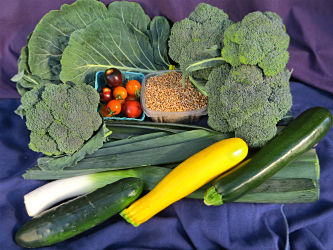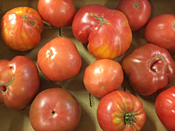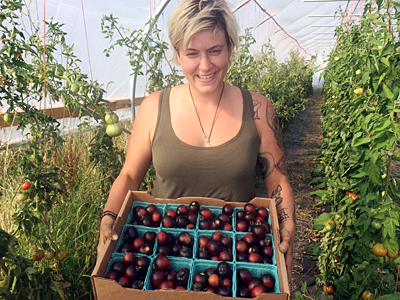
Standard
Leeks 2
Broccoli 3 lb
Collards 1 bu
Apples 2 lb
Triticale Berries 1 pt
Potatoes 2 lb
Red Cabbage 1 hd
Heirloom Tomatoes .5 lb
Slicer Tomatoes 1 lb

Small
Leeks 2
Broccoli 3 lb
Collards 1 bu
Cherry Tomatoes .5 pt
Triticale Berries 1 pt
Zucchini 1
Cucumber 1
Easy Summer Grain Salad—Using lots of the veggies in your box!
All ingredients are optional, and quantities are suggestions, not rules. Feel free to add other ingredients, like cauliflower or spinach. For even more flavor, add herbs like parsley, basil or dill. The quantities can easily be increased for summertime parties.
Veggies
1/2 pound triticale berries or other wheat berries
1/2 pint cherry tomatoes or regular-sized heirloom tomatoes, chopped
1 cucumber, chopped
1/2 bunch of your favorite kale, coarsely chopped
1 head broccoli, chopped
1/2 Walla Walla sweet onion (or sweet red onion)
2 carrots, shredded
1 beet (any variety), shredded
Dressing
1/3 cup olive oil
1/3 cup white wine vinegar
Juice of 1 lemon
2 clovers garlic, chopped
Soak the triticale berries overnight. The next day, drain the triticale berries, then add enough fresh water to cover them with about 1″ of water. Boil about 1 hour until berries are plump and chewy. Drain and cool.
In the meantime, chop your veggies. Once the triticale berries cool, mix the dressing ingredients together and pour over the berries, then add your veggies and mix everything together. Let the flavors mingle for a few hours in the fridge before serving.
We thank our packing shed manager, Rachel Covault, for this great recipe idea.
Tomatoes

200 years ago, tomatoes were thought to be poisonous in the United States. This may be because tomatoes are part of the night shade family, some of which are truly poisonous. But a diet that includes this tasty fruit gives you benefits like lowering the risk of heart disease, diabetes, and cancer.
Tomatoes, with their rich red/purple color, like the beautiful Indigo Cherry Drops that Sidney is showing us in the photo below, are rich in lycopene, a phytochemical that plays a role in preventing chronic diseases. They are also rich sources of vitamin C and other antioxidants that help combat free radicals know to cause cancer, especially prostate, lung and stomach cancers.
Tomatoes are also high in fiber, potassium, and choline, for heart health. An increase in potassium intake along with a decrease in sodium intake can be one of the most important dietary changes that the average person can make to reduce their risk of cardiovascular disease.

Tomatoes are also delicious, especially if they are vine-ripened. We are so accustomed to having tomatoes whenever we want them, but that sweet, tangy, juicy bomb of flavor can only happen when tomatoes are eaten in season, not shipped green from Latin America or China in the winter, and chemically forced to change color to red. Those are some kind of pathetic cardboard imitation. Real vine-ripened tomatoes are worth waiting for, and heirlooms, the wild children of the tomato world, come in fantastic shapes and colors that have a true tomato flavor that rivals any hybrid.
How to use your tomatoes
- Put in a salad
- Put on a pizza
- Cut in half down the equator, top with seasoned breadcrumbs, then broil
- Add to soups and stews
- Braise or sauté with fish or chicken, Italian seasoning, olives and capers
- Slice thick and slow roast (225°F for 2 hours)
- Use cherry tomatoes for kebabs
- Stuff tomatoes with ground beef or pork, bacon, rice, spinach, or cracked wheat
- Combine fresh tomato puree, mint, sugar, champagne and fresh lemon juice for a refreshing sorbet
- Add zip to tuna salad by adding tomatoes, green onions and a touch of chopped fresh basil
- Green and yellow tomatoes make great toppers for eggs and enchiladas.
From Bounty from the Box, the CSA Farm Cookbook by Mi Ae Lipe.
